Analyzing HSE Effects: Downstream Oil & Gas Production in Netherlands
VerifiedAdded on 2023/05/28
|12
|3173
|254
Report
AI Summary
This report critically analyzes the impact of the downstream oil and gas sector on health, safety, and the environment in the Netherlands. It addresses the health and safety risks faced by workers due to exposure to chemicals and hazardous conditions, as well as the environmental pollution caused by refining processes, including air and water contamination. The research aims to enhance health and safety standards while protecting the environment, focusing on assessing health and safety effects on workers, rectifying environmental impacts, and examining relevant research questions. The methodology proposes using a positivism research philosophy with a deductive approach, acknowledging limitations such as time and funding constraints. It also highlights the importance of proper safety measures and equipment, addresses physical, ergonomic, and biological hazards, and references various reports and studies on fatality rates, injury causes, and pollution sources within the industry.
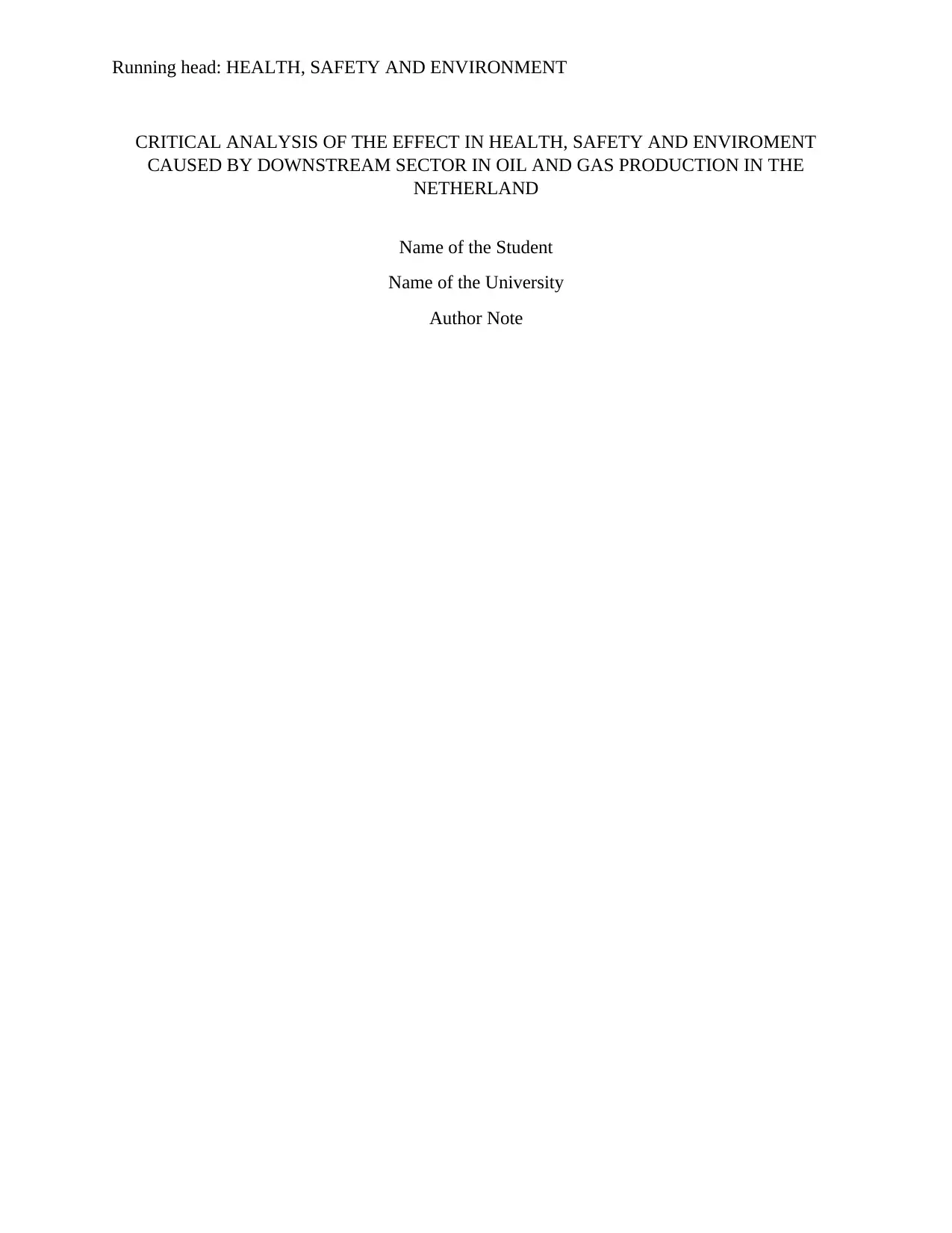
Running head: HEALTH, SAFETY AND ENVIRONMENT
CRITICAL ANALYSIS OF THE EFFECT IN HEALTH, SAFETY AND ENVIROMENT
CAUSED BY DOWNSTREAM SECTOR IN OIL AND GAS PRODUCTION IN THE
NETHERLAND
Name of the Student
Name of the University
Author Note
CRITICAL ANALYSIS OF THE EFFECT IN HEALTH, SAFETY AND ENVIROMENT
CAUSED BY DOWNSTREAM SECTOR IN OIL AND GAS PRODUCTION IN THE
NETHERLAND
Name of the Student
Name of the University
Author Note
Paraphrase This Document
Need a fresh take? Get an instant paraphrase of this document with our AI Paraphraser
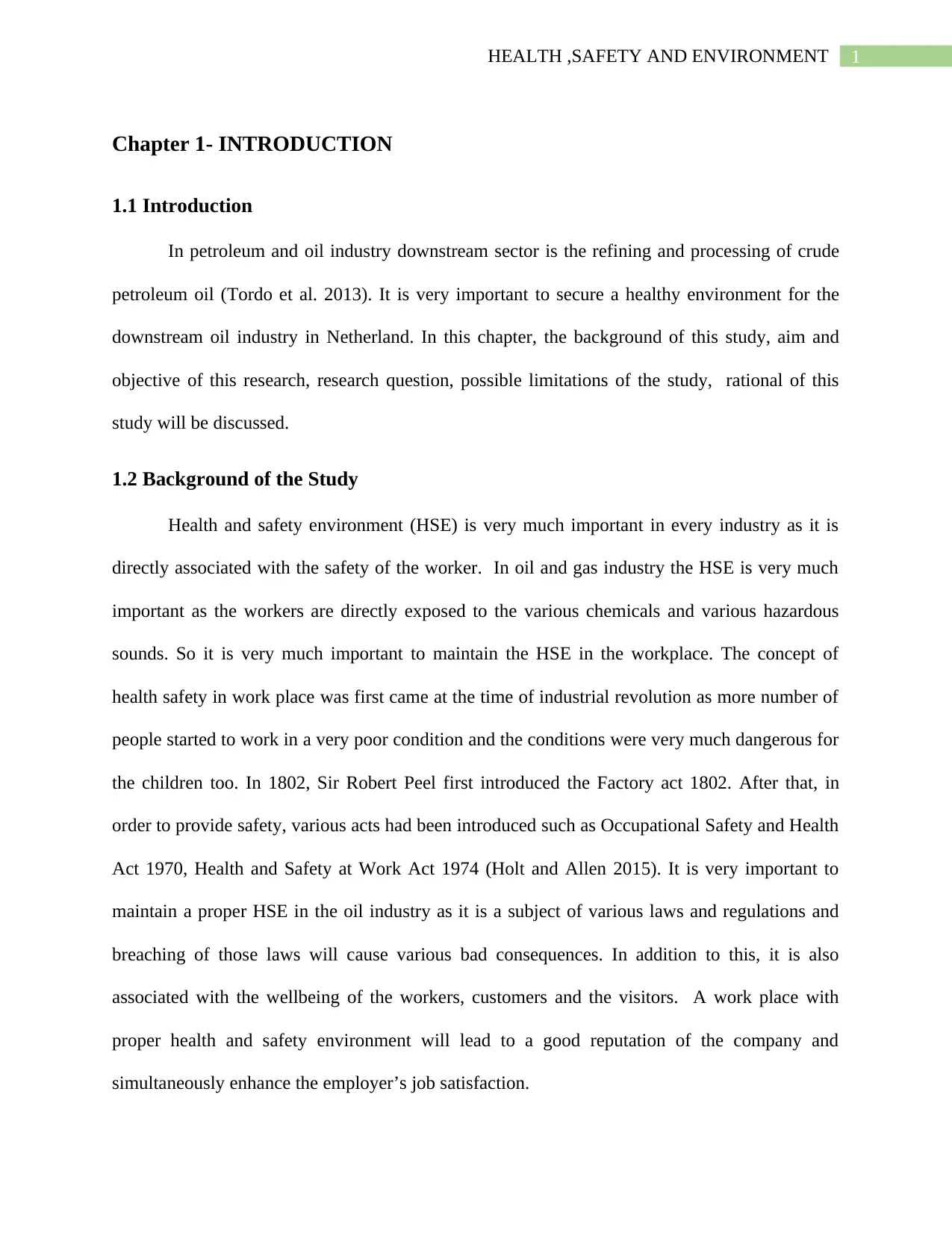
1HEALTH ,SAFETY AND ENVIRONMENT
Chapter 1- INTRODUCTION
1.1 Introduction
In petroleum and oil industry downstream sector is the refining and processing of crude
petroleum oil (Tordo et al. 2013). It is very important to secure a healthy environment for the
downstream oil industry in Netherland. In this chapter, the background of this study, aim and
objective of this research, research question, possible limitations of the study, rational of this
study will be discussed.
1.2 Background of the Study
Health and safety environment (HSE) is very much important in every industry as it is
directly associated with the safety of the worker. In oil and gas industry the HSE is very much
important as the workers are directly exposed to the various chemicals and various hazardous
sounds. So it is very much important to maintain the HSE in the workplace. The concept of
health safety in work place was first came at the time of industrial revolution as more number of
people started to work in a very poor condition and the conditions were very much dangerous for
the children too. In 1802, Sir Robert Peel first introduced the Factory act 1802. After that, in
order to provide safety, various acts had been introduced such as Occupational Safety and Health
Act 1970, Health and Safety at Work Act 1974 (Holt and Allen 2015). It is very important to
maintain a proper HSE in the oil industry as it is a subject of various laws and regulations and
breaching of those laws will cause various bad consequences. In addition to this, it is also
associated with the wellbeing of the workers, customers and the visitors. A work place with
proper health and safety environment will lead to a good reputation of the company and
simultaneously enhance the employer’s job satisfaction.
Chapter 1- INTRODUCTION
1.1 Introduction
In petroleum and oil industry downstream sector is the refining and processing of crude
petroleum oil (Tordo et al. 2013). It is very important to secure a healthy environment for the
downstream oil industry in Netherland. In this chapter, the background of this study, aim and
objective of this research, research question, possible limitations of the study, rational of this
study will be discussed.
1.2 Background of the Study
Health and safety environment (HSE) is very much important in every industry as it is
directly associated with the safety of the worker. In oil and gas industry the HSE is very much
important as the workers are directly exposed to the various chemicals and various hazardous
sounds. So it is very much important to maintain the HSE in the workplace. The concept of
health safety in work place was first came at the time of industrial revolution as more number of
people started to work in a very poor condition and the conditions were very much dangerous for
the children too. In 1802, Sir Robert Peel first introduced the Factory act 1802. After that, in
order to provide safety, various acts had been introduced such as Occupational Safety and Health
Act 1970, Health and Safety at Work Act 1974 (Holt and Allen 2015). It is very important to
maintain a proper HSE in the oil industry as it is a subject of various laws and regulations and
breaching of those laws will cause various bad consequences. In addition to this, it is also
associated with the wellbeing of the workers, customers and the visitors. A work place with
proper health and safety environment will lead to a good reputation of the company and
simultaneously enhance the employer’s job satisfaction.
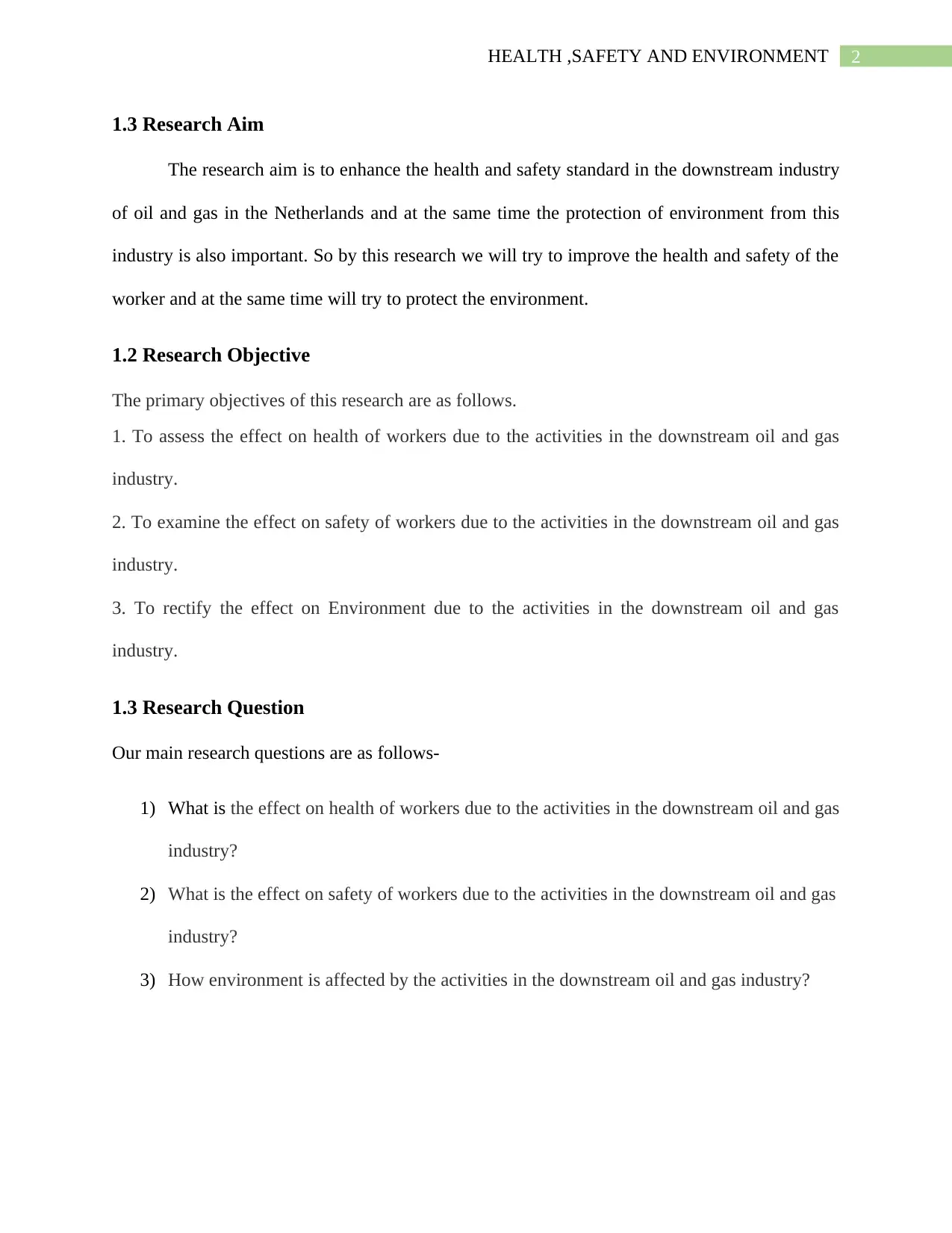
2HEALTH ,SAFETY AND ENVIRONMENT
1.3 Research Aim
The research aim is to enhance the health and safety standard in the downstream industry
of oil and gas in the Netherlands and at the same time the protection of environment from this
industry is also important. So by this research we will try to improve the health and safety of the
worker and at the same time will try to protect the environment.
1.2 Research Objective
The primary objectives of this research are as follows.
1. To assess the effect on health of workers due to the activities in the downstream oil and gas
industry.
2. To examine the effect on safety of workers due to the activities in the downstream oil and gas
industry.
3. To rectify the effect on Environment due to the activities in the downstream oil and gas
industry.
1.3 Research Question
Our main research questions are as follows-
1) What is the effect on health of workers due to the activities in the downstream oil and gas
industry?
2) What is the effect on safety of workers due to the activities in the downstream oil and gas
industry?
3) How environment is affected by the activities in the downstream oil and gas industry?
1.3 Research Aim
The research aim is to enhance the health and safety standard in the downstream industry
of oil and gas in the Netherlands and at the same time the protection of environment from this
industry is also important. So by this research we will try to improve the health and safety of the
worker and at the same time will try to protect the environment.
1.2 Research Objective
The primary objectives of this research are as follows.
1. To assess the effect on health of workers due to the activities in the downstream oil and gas
industry.
2. To examine the effect on safety of workers due to the activities in the downstream oil and gas
industry.
3. To rectify the effect on Environment due to the activities in the downstream oil and gas
industry.
1.3 Research Question
Our main research questions are as follows-
1) What is the effect on health of workers due to the activities in the downstream oil and gas
industry?
2) What is the effect on safety of workers due to the activities in the downstream oil and gas
industry?
3) How environment is affected by the activities in the downstream oil and gas industry?
⊘ This is a preview!⊘
Do you want full access?
Subscribe today to unlock all pages.

Trusted by 1+ million students worldwide
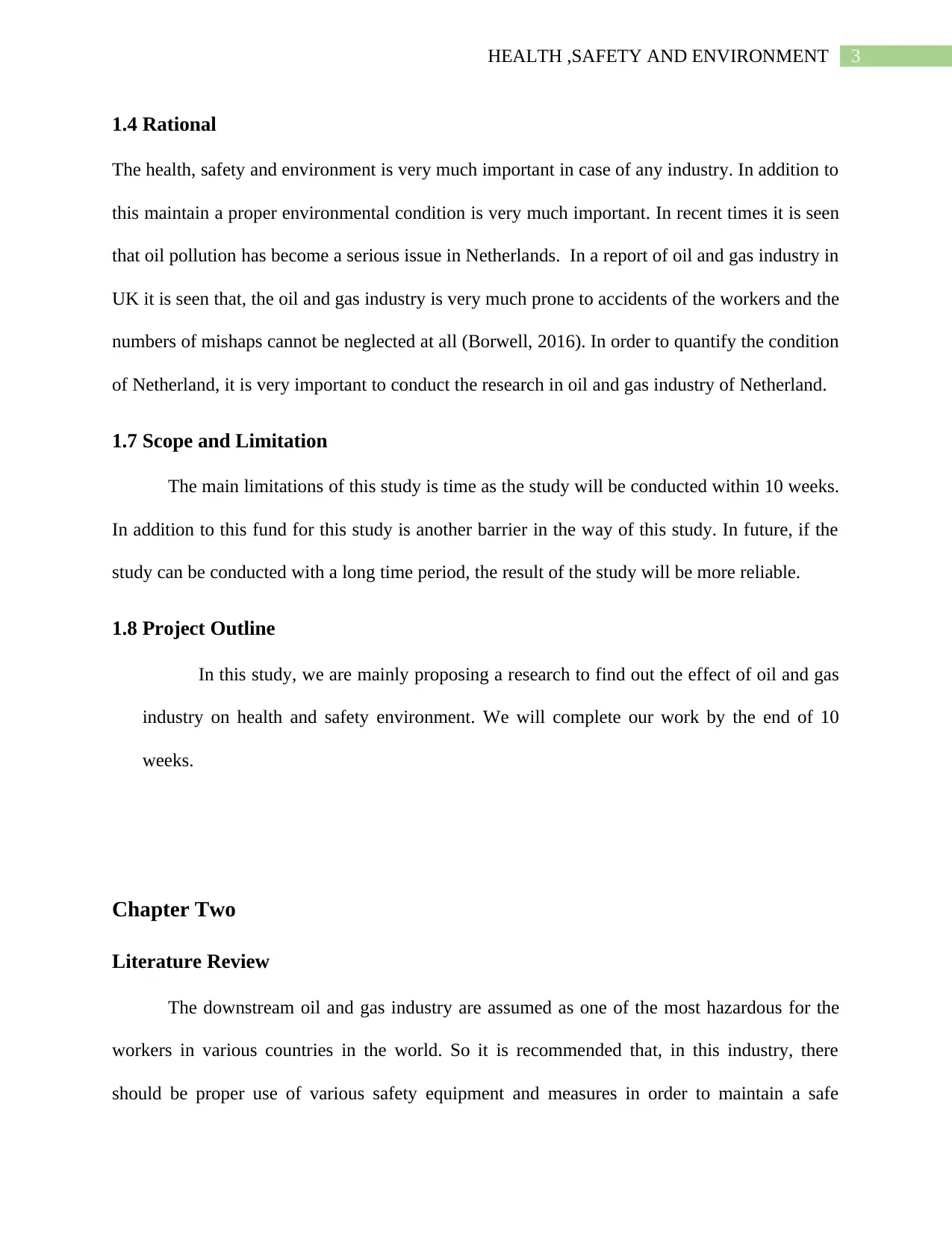
3HEALTH ,SAFETY AND ENVIRONMENT
1.4 Rational
The health, safety and environment is very much important in case of any industry. In addition to
this maintain a proper environmental condition is very much important. In recent times it is seen
that oil pollution has become a serious issue in Netherlands. In a report of oil and gas industry in
UK it is seen that, the oil and gas industry is very much prone to accidents of the workers and the
numbers of mishaps cannot be neglected at all (Borwell, 2016). In order to quantify the condition
of Netherland, it is very important to conduct the research in oil and gas industry of Netherland.
1.7 Scope and Limitation
The main limitations of this study is time as the study will be conducted within 10 weeks.
In addition to this fund for this study is another barrier in the way of this study. In future, if the
study can be conducted with a long time period, the result of the study will be more reliable.
1.8 Project Outline
In this study, we are mainly proposing a research to find out the effect of oil and gas
industry on health and safety environment. We will complete our work by the end of 10
weeks.
Chapter Two
Literature Review
The downstream oil and gas industry are assumed as one of the most hazardous for the
workers in various countries in the world. So it is recommended that, in this industry, there
should be proper use of various safety equipment and measures in order to maintain a safe
1.4 Rational
The health, safety and environment is very much important in case of any industry. In addition to
this maintain a proper environmental condition is very much important. In recent times it is seen
that oil pollution has become a serious issue in Netherlands. In a report of oil and gas industry in
UK it is seen that, the oil and gas industry is very much prone to accidents of the workers and the
numbers of mishaps cannot be neglected at all (Borwell, 2016). In order to quantify the condition
of Netherland, it is very important to conduct the research in oil and gas industry of Netherland.
1.7 Scope and Limitation
The main limitations of this study is time as the study will be conducted within 10 weeks.
In addition to this fund for this study is another barrier in the way of this study. In future, if the
study can be conducted with a long time period, the result of the study will be more reliable.
1.8 Project Outline
In this study, we are mainly proposing a research to find out the effect of oil and gas
industry on health and safety environment. We will complete our work by the end of 10
weeks.
Chapter Two
Literature Review
The downstream oil and gas industry are assumed as one of the most hazardous for the
workers in various countries in the world. So it is recommended that, in this industry, there
should be proper use of various safety equipment and measures in order to maintain a safe
Paraphrase This Document
Need a fresh take? Get an instant paraphrase of this document with our AI Paraphraser
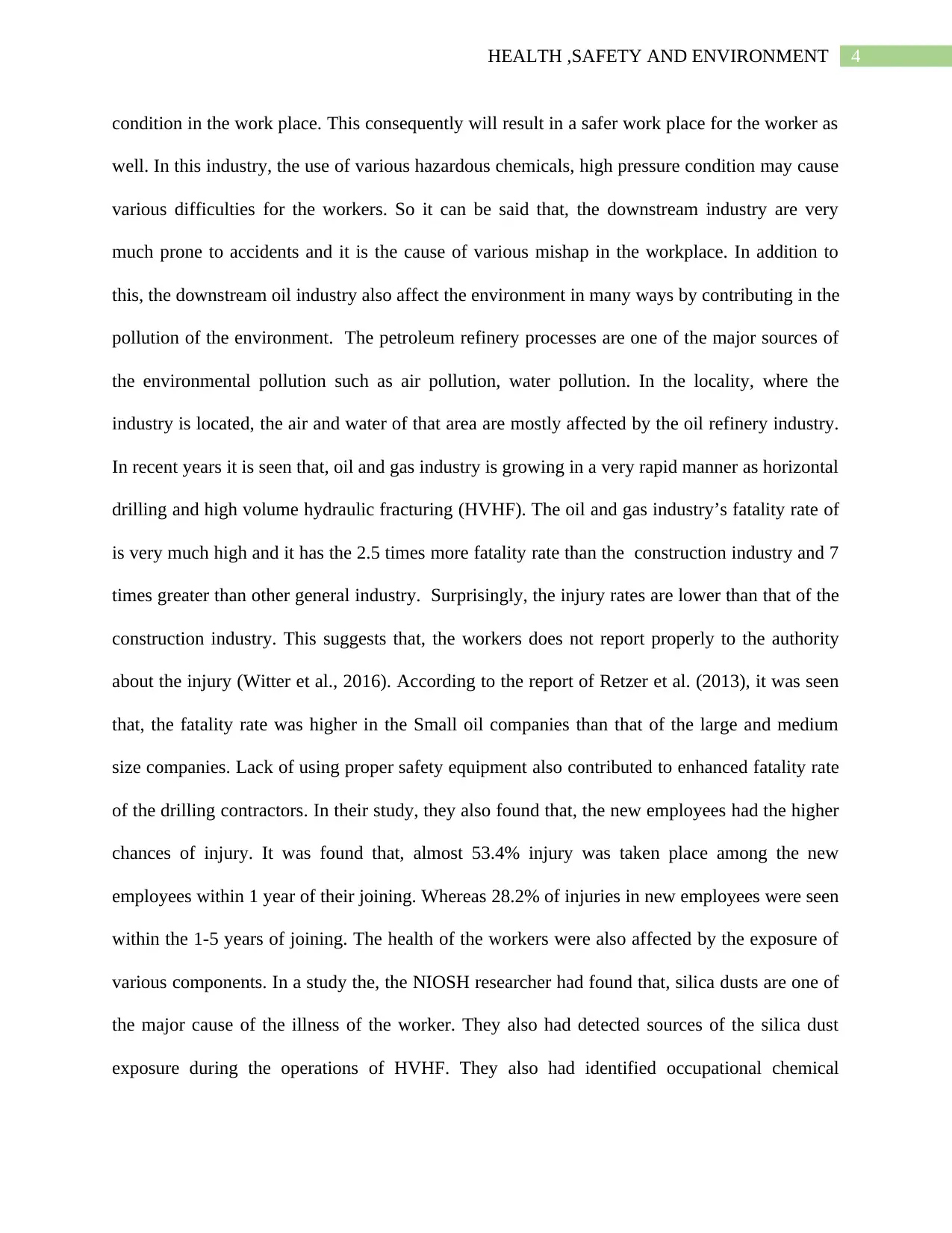
4HEALTH ,SAFETY AND ENVIRONMENT
condition in the work place. This consequently will result in a safer work place for the worker as
well. In this industry, the use of various hazardous chemicals, high pressure condition may cause
various difficulties for the workers. So it can be said that, the downstream industry are very
much prone to accidents and it is the cause of various mishap in the workplace. In addition to
this, the downstream oil industry also affect the environment in many ways by contributing in the
pollution of the environment. The petroleum refinery processes are one of the major sources of
the environmental pollution such as air pollution, water pollution. In the locality, where the
industry is located, the air and water of that area are mostly affected by the oil refinery industry.
In recent years it is seen that, oil and gas industry is growing in a very rapid manner as horizontal
drilling and high volume hydraulic fracturing (HVHF). The oil and gas industry’s fatality rate of
is very much high and it has the 2.5 times more fatality rate than the construction industry and 7
times greater than other general industry. Surprisingly, the injury rates are lower than that of the
construction industry. This suggests that, the workers does not report properly to the authority
about the injury (Witter et al., 2016). According to the report of Retzer et al. (2013), it was seen
that, the fatality rate was higher in the Small oil companies than that of the large and medium
size companies. Lack of using proper safety equipment also contributed to enhanced fatality rate
of the drilling contractors. In their study, they also found that, the new employees had the higher
chances of injury. It was found that, almost 53.4% injury was taken place among the new
employees within 1 year of their joining. Whereas 28.2% of injuries in new employees were seen
within the 1-5 years of joining. The health of the workers were also affected by the exposure of
various components. In a study the, the NIOSH researcher had found that, silica dusts are one of
the major cause of the illness of the worker. They also had detected sources of the silica dust
exposure during the operations of HVHF. They also had identified occupational chemical
condition in the work place. This consequently will result in a safer work place for the worker as
well. In this industry, the use of various hazardous chemicals, high pressure condition may cause
various difficulties for the workers. So it can be said that, the downstream industry are very
much prone to accidents and it is the cause of various mishap in the workplace. In addition to
this, the downstream oil industry also affect the environment in many ways by contributing in the
pollution of the environment. The petroleum refinery processes are one of the major sources of
the environmental pollution such as air pollution, water pollution. In the locality, where the
industry is located, the air and water of that area are mostly affected by the oil refinery industry.
In recent years it is seen that, oil and gas industry is growing in a very rapid manner as horizontal
drilling and high volume hydraulic fracturing (HVHF). The oil and gas industry’s fatality rate of
is very much high and it has the 2.5 times more fatality rate than the construction industry and 7
times greater than other general industry. Surprisingly, the injury rates are lower than that of the
construction industry. This suggests that, the workers does not report properly to the authority
about the injury (Witter et al., 2016). According to the report of Retzer et al. (2013), it was seen
that, the fatality rate was higher in the Small oil companies than that of the large and medium
size companies. Lack of using proper safety equipment also contributed to enhanced fatality rate
of the drilling contractors. In their study, they also found that, the new employees had the higher
chances of injury. It was found that, almost 53.4% injury was taken place among the new
employees within 1 year of their joining. Whereas 28.2% of injuries in new employees were seen
within the 1-5 years of joining. The health of the workers were also affected by the exposure of
various components. In a study the, the NIOSH researcher had found that, silica dusts are one of
the major cause of the illness of the worker. They also had detected sources of the silica dust
exposure during the operations of HVHF. They also had identified occupational chemical
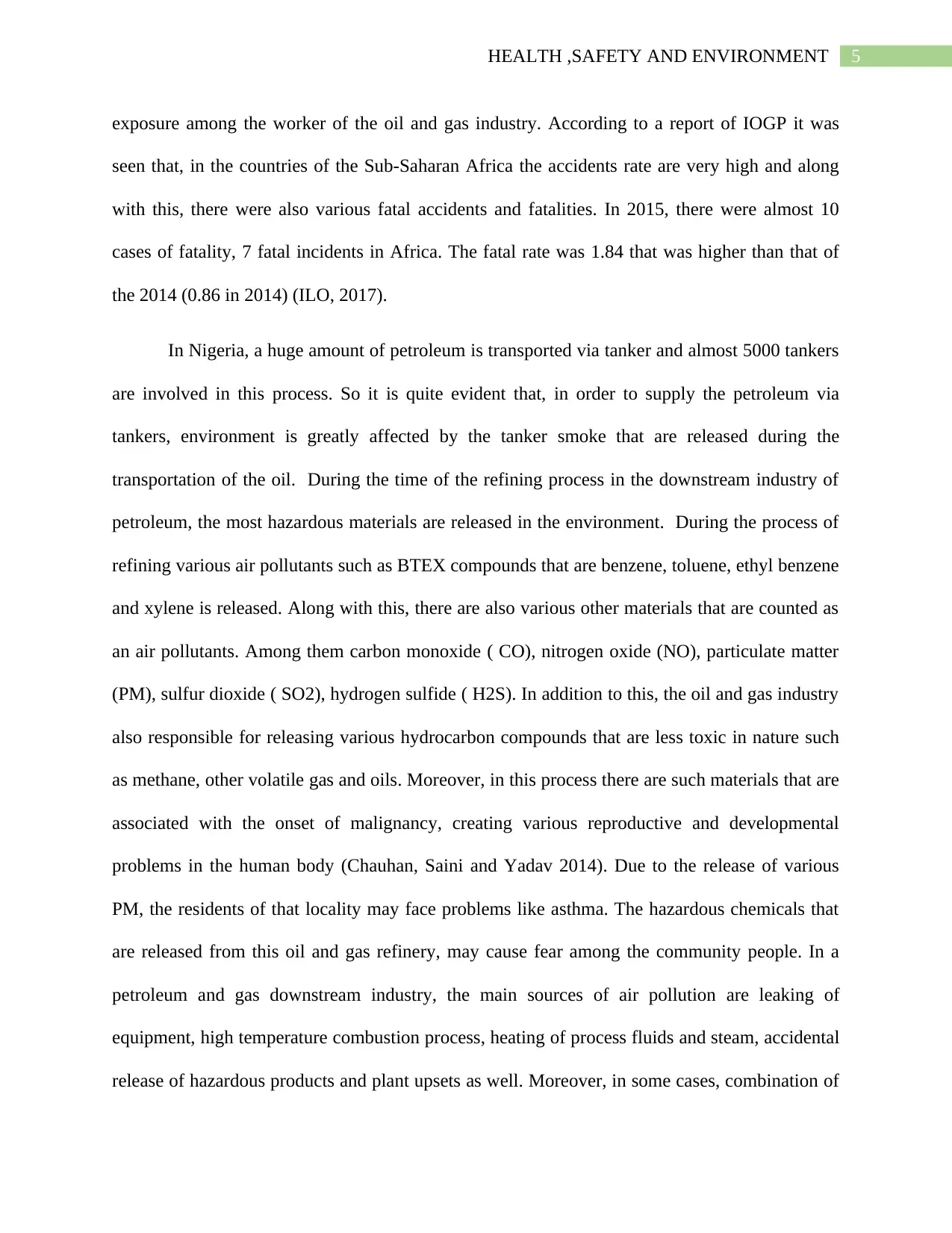
5HEALTH ,SAFETY AND ENVIRONMENT
exposure among the worker of the oil and gas industry. According to a report of IOGP it was
seen that, in the countries of the Sub-Saharan Africa the accidents rate are very high and along
with this, there were also various fatal accidents and fatalities. In 2015, there were almost 10
cases of fatality, 7 fatal incidents in Africa. The fatal rate was 1.84 that was higher than that of
the 2014 (0.86 in 2014) (ILO, 2017).
In Nigeria, a huge amount of petroleum is transported via tanker and almost 5000 tankers
are involved in this process. So it is quite evident that, in order to supply the petroleum via
tankers, environment is greatly affected by the tanker smoke that are released during the
transportation of the oil. During the time of the refining process in the downstream industry of
petroleum, the most hazardous materials are released in the environment. During the process of
refining various air pollutants such as BTEX compounds that are benzene, toluene, ethyl benzene
and xylene is released. Along with this, there are also various other materials that are counted as
an air pollutants. Among them carbon monoxide ( CO), nitrogen oxide (NO), particulate matter
(PM), sulfur dioxide ( SO2), hydrogen sulfide ( H2S). In addition to this, the oil and gas industry
also responsible for releasing various hydrocarbon compounds that are less toxic in nature such
as methane, other volatile gas and oils. Moreover, in this process there are such materials that are
associated with the onset of malignancy, creating various reproductive and developmental
problems in the human body (Chauhan, Saini and Yadav 2014). Due to the release of various
PM, the residents of that locality may face problems like asthma. The hazardous chemicals that
are released from this oil and gas refinery, may cause fear among the community people. In a
petroleum and gas downstream industry, the main sources of air pollution are leaking of
equipment, high temperature combustion process, heating of process fluids and steam, accidental
release of hazardous products and plant upsets as well. Moreover, in some cases, combination of
exposure among the worker of the oil and gas industry. According to a report of IOGP it was
seen that, in the countries of the Sub-Saharan Africa the accidents rate are very high and along
with this, there were also various fatal accidents and fatalities. In 2015, there were almost 10
cases of fatality, 7 fatal incidents in Africa. The fatal rate was 1.84 that was higher than that of
the 2014 (0.86 in 2014) (ILO, 2017).
In Nigeria, a huge amount of petroleum is transported via tanker and almost 5000 tankers
are involved in this process. So it is quite evident that, in order to supply the petroleum via
tankers, environment is greatly affected by the tanker smoke that are released during the
transportation of the oil. During the time of the refining process in the downstream industry of
petroleum, the most hazardous materials are released in the environment. During the process of
refining various air pollutants such as BTEX compounds that are benzene, toluene, ethyl benzene
and xylene is released. Along with this, there are also various other materials that are counted as
an air pollutants. Among them carbon monoxide ( CO), nitrogen oxide (NO), particulate matter
(PM), sulfur dioxide ( SO2), hydrogen sulfide ( H2S). In addition to this, the oil and gas industry
also responsible for releasing various hydrocarbon compounds that are less toxic in nature such
as methane, other volatile gas and oils. Moreover, in this process there are such materials that are
associated with the onset of malignancy, creating various reproductive and developmental
problems in the human body (Chauhan, Saini and Yadav 2014). Due to the release of various
PM, the residents of that locality may face problems like asthma. The hazardous chemicals that
are released from this oil and gas refinery, may cause fear among the community people. In a
petroleum and gas downstream industry, the main sources of air pollution are leaking of
equipment, high temperature combustion process, heating of process fluids and steam, accidental
release of hazardous products and plant upsets as well. Moreover, in some cases, combination of
⊘ This is a preview!⊘
Do you want full access?
Subscribe today to unlock all pages.

Trusted by 1+ million students worldwide
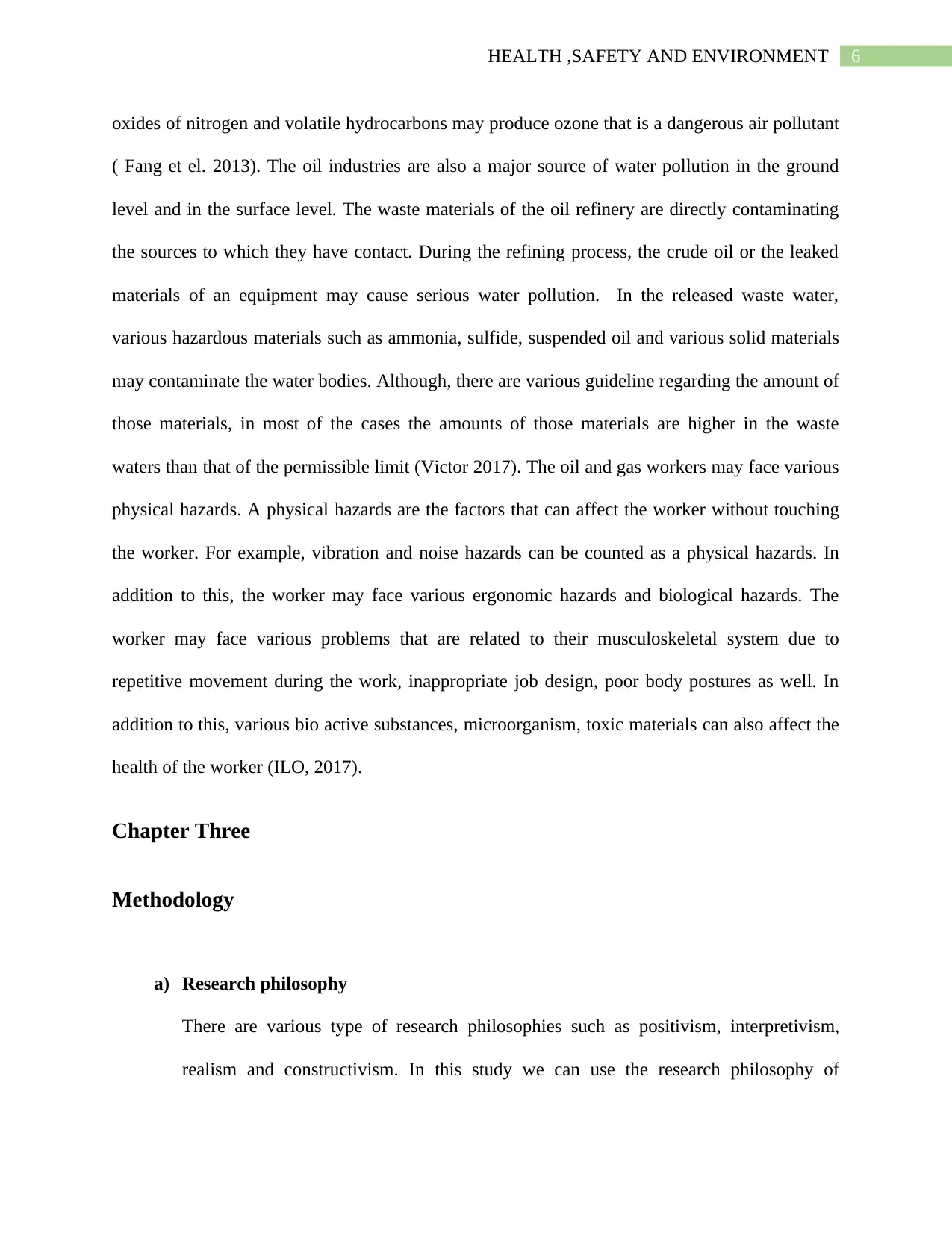
6HEALTH ,SAFETY AND ENVIRONMENT
oxides of nitrogen and volatile hydrocarbons may produce ozone that is a dangerous air pollutant
( Fang et el. 2013). The oil industries are also a major source of water pollution in the ground
level and in the surface level. The waste materials of the oil refinery are directly contaminating
the sources to which they have contact. During the refining process, the crude oil or the leaked
materials of an equipment may cause serious water pollution. In the released waste water,
various hazardous materials such as ammonia, sulfide, suspended oil and various solid materials
may contaminate the water bodies. Although, there are various guideline regarding the amount of
those materials, in most of the cases the amounts of those materials are higher in the waste
waters than that of the permissible limit (Victor 2017). The oil and gas workers may face various
physical hazards. A physical hazards are the factors that can affect the worker without touching
the worker. For example, vibration and noise hazards can be counted as a physical hazards. In
addition to this, the worker may face various ergonomic hazards and biological hazards. The
worker may face various problems that are related to their musculoskeletal system due to
repetitive movement during the work, inappropriate job design, poor body postures as well. In
addition to this, various bio active substances, microorganism, toxic materials can also affect the
health of the worker (ILO, 2017).
Chapter Three
Methodology
a) Research philosophy
There are various type of research philosophies such as positivism, interpretivism,
realism and constructivism. In this study we can use the research philosophy of
oxides of nitrogen and volatile hydrocarbons may produce ozone that is a dangerous air pollutant
( Fang et el. 2013). The oil industries are also a major source of water pollution in the ground
level and in the surface level. The waste materials of the oil refinery are directly contaminating
the sources to which they have contact. During the refining process, the crude oil or the leaked
materials of an equipment may cause serious water pollution. In the released waste water,
various hazardous materials such as ammonia, sulfide, suspended oil and various solid materials
may contaminate the water bodies. Although, there are various guideline regarding the amount of
those materials, in most of the cases the amounts of those materials are higher in the waste
waters than that of the permissible limit (Victor 2017). The oil and gas workers may face various
physical hazards. A physical hazards are the factors that can affect the worker without touching
the worker. For example, vibration and noise hazards can be counted as a physical hazards. In
addition to this, the worker may face various ergonomic hazards and biological hazards. The
worker may face various problems that are related to their musculoskeletal system due to
repetitive movement during the work, inappropriate job design, poor body postures as well. In
addition to this, various bio active substances, microorganism, toxic materials can also affect the
health of the worker (ILO, 2017).
Chapter Three
Methodology
a) Research philosophy
There are various type of research philosophies such as positivism, interpretivism,
realism and constructivism. In this study we can use the research philosophy of
Paraphrase This Document
Need a fresh take? Get an instant paraphrase of this document with our AI Paraphraser
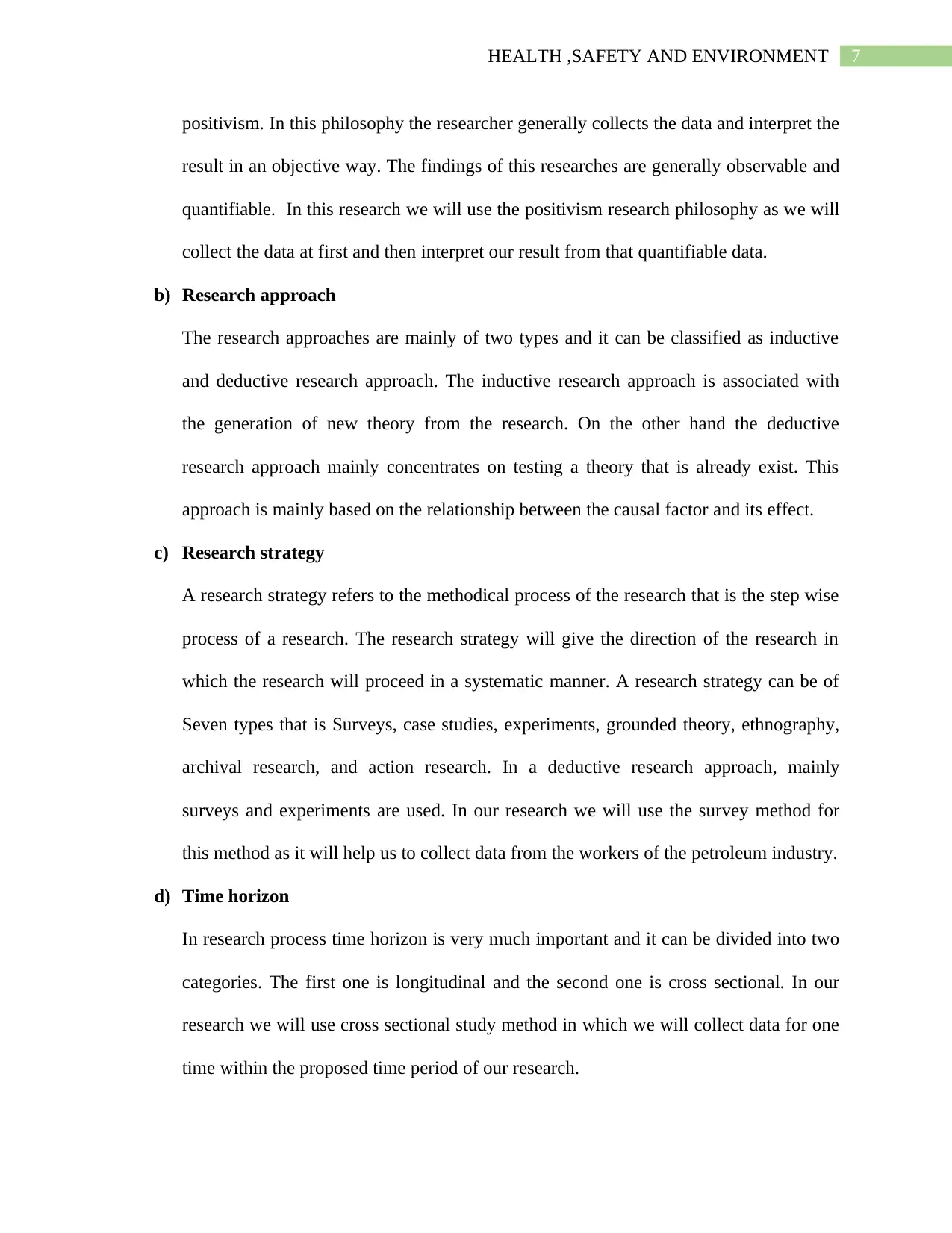
7HEALTH ,SAFETY AND ENVIRONMENT
positivism. In this philosophy the researcher generally collects the data and interpret the
result in an objective way. The findings of this researches are generally observable and
quantifiable. In this research we will use the positivism research philosophy as we will
collect the data at first and then interpret our result from that quantifiable data.
b) Research approach
The research approaches are mainly of two types and it can be classified as inductive
and deductive research approach. The inductive research approach is associated with
the generation of new theory from the research. On the other hand the deductive
research approach mainly concentrates on testing a theory that is already exist. This
approach is mainly based on the relationship between the causal factor and its effect.
c) Research strategy
A research strategy refers to the methodical process of the research that is the step wise
process of a research. The research strategy will give the direction of the research in
which the research will proceed in a systematic manner. A research strategy can be of
Seven types that is Surveys, case studies, experiments, grounded theory, ethnography,
archival research, and action research. In a deductive research approach, mainly
surveys and experiments are used. In our research we will use the survey method for
this method as it will help us to collect data from the workers of the petroleum industry.
d) Time horizon
In research process time horizon is very much important and it can be divided into two
categories. The first one is longitudinal and the second one is cross sectional. In our
research we will use cross sectional study method in which we will collect data for one
time within the proposed time period of our research.
positivism. In this philosophy the researcher generally collects the data and interpret the
result in an objective way. The findings of this researches are generally observable and
quantifiable. In this research we will use the positivism research philosophy as we will
collect the data at first and then interpret our result from that quantifiable data.
b) Research approach
The research approaches are mainly of two types and it can be classified as inductive
and deductive research approach. The inductive research approach is associated with
the generation of new theory from the research. On the other hand the deductive
research approach mainly concentrates on testing a theory that is already exist. This
approach is mainly based on the relationship between the causal factor and its effect.
c) Research strategy
A research strategy refers to the methodical process of the research that is the step wise
process of a research. The research strategy will give the direction of the research in
which the research will proceed in a systematic manner. A research strategy can be of
Seven types that is Surveys, case studies, experiments, grounded theory, ethnography,
archival research, and action research. In a deductive research approach, mainly
surveys and experiments are used. In our research we will use the survey method for
this method as it will help us to collect data from the workers of the petroleum industry.
d) Time horizon
In research process time horizon is very much important and it can be divided into two
categories. The first one is longitudinal and the second one is cross sectional. In our
research we will use cross sectional study method in which we will collect data for one
time within the proposed time period of our research.
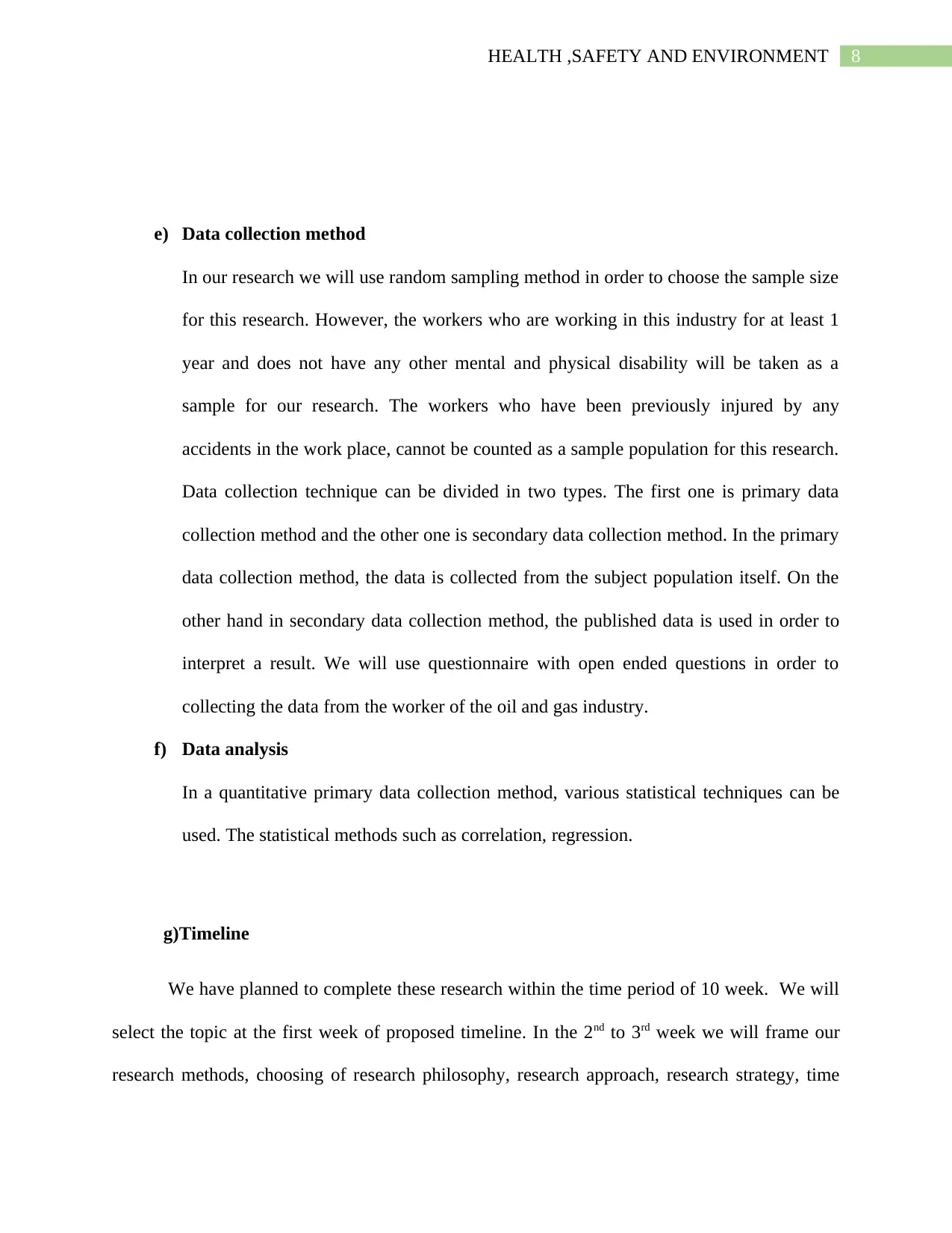
8HEALTH ,SAFETY AND ENVIRONMENT
e) Data collection method
In our research we will use random sampling method in order to choose the sample size
for this research. However, the workers who are working in this industry for at least 1
year and does not have any other mental and physical disability will be taken as a
sample for our research. The workers who have been previously injured by any
accidents in the work place, cannot be counted as a sample population for this research.
Data collection technique can be divided in two types. The first one is primary data
collection method and the other one is secondary data collection method. In the primary
data collection method, the data is collected from the subject population itself. On the
other hand in secondary data collection method, the published data is used in order to
interpret a result. We will use questionnaire with open ended questions in order to
collecting the data from the worker of the oil and gas industry.
f) Data analysis
In a quantitative primary data collection method, various statistical techniques can be
used. The statistical methods such as correlation, regression.
g)Timeline
We have planned to complete these research within the time period of 10 week. We will
select the topic at the first week of proposed timeline. In the 2nd to 3rd week we will frame our
research methods, choosing of research philosophy, research approach, research strategy, time
e) Data collection method
In our research we will use random sampling method in order to choose the sample size
for this research. However, the workers who are working in this industry for at least 1
year and does not have any other mental and physical disability will be taken as a
sample for our research. The workers who have been previously injured by any
accidents in the work place, cannot be counted as a sample population for this research.
Data collection technique can be divided in two types. The first one is primary data
collection method and the other one is secondary data collection method. In the primary
data collection method, the data is collected from the subject population itself. On the
other hand in secondary data collection method, the published data is used in order to
interpret a result. We will use questionnaire with open ended questions in order to
collecting the data from the worker of the oil and gas industry.
f) Data analysis
In a quantitative primary data collection method, various statistical techniques can be
used. The statistical methods such as correlation, regression.
g)Timeline
We have planned to complete these research within the time period of 10 week. We will
select the topic at the first week of proposed timeline. In the 2nd to 3rd week we will frame our
research methods, choosing of research philosophy, research approach, research strategy, time
⊘ This is a preview!⊘
Do you want full access?
Subscribe today to unlock all pages.

Trusted by 1+ million students worldwide
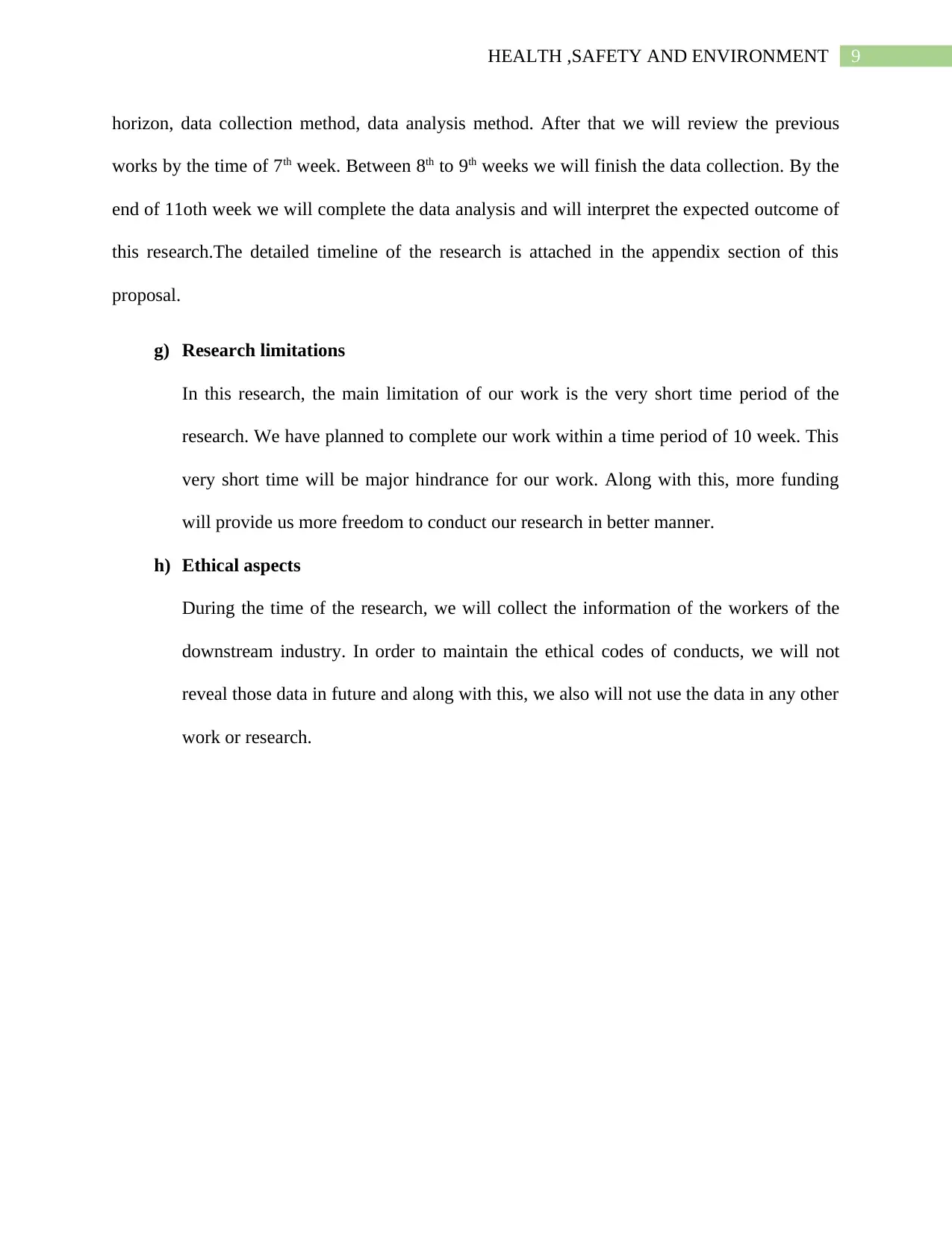
9HEALTH ,SAFETY AND ENVIRONMENT
horizon, data collection method, data analysis method. After that we will review the previous
works by the time of 7th week. Between 8th to 9th weeks we will finish the data collection. By the
end of 11oth week we will complete the data analysis and will interpret the expected outcome of
this research.The detailed timeline of the research is attached in the appendix section of this
proposal.
g) Research limitations
In this research, the main limitation of our work is the very short time period of the
research. We have planned to complete our work within a time period of 10 week. This
very short time will be major hindrance for our work. Along with this, more funding
will provide us more freedom to conduct our research in better manner.
h) Ethical aspects
During the time of the research, we will collect the information of the workers of the
downstream industry. In order to maintain the ethical codes of conducts, we will not
reveal those data in future and along with this, we also will not use the data in any other
work or research.
horizon, data collection method, data analysis method. After that we will review the previous
works by the time of 7th week. Between 8th to 9th weeks we will finish the data collection. By the
end of 11oth week we will complete the data analysis and will interpret the expected outcome of
this research.The detailed timeline of the research is attached in the appendix section of this
proposal.
g) Research limitations
In this research, the main limitation of our work is the very short time period of the
research. We have planned to complete our work within a time period of 10 week. This
very short time will be major hindrance for our work. Along with this, more funding
will provide us more freedom to conduct our research in better manner.
h) Ethical aspects
During the time of the research, we will collect the information of the workers of the
downstream industry. In order to maintain the ethical codes of conducts, we will not
reveal those data in future and along with this, we also will not use the data in any other
work or research.
Paraphrase This Document
Need a fresh take? Get an instant paraphrase of this document with our AI Paraphraser
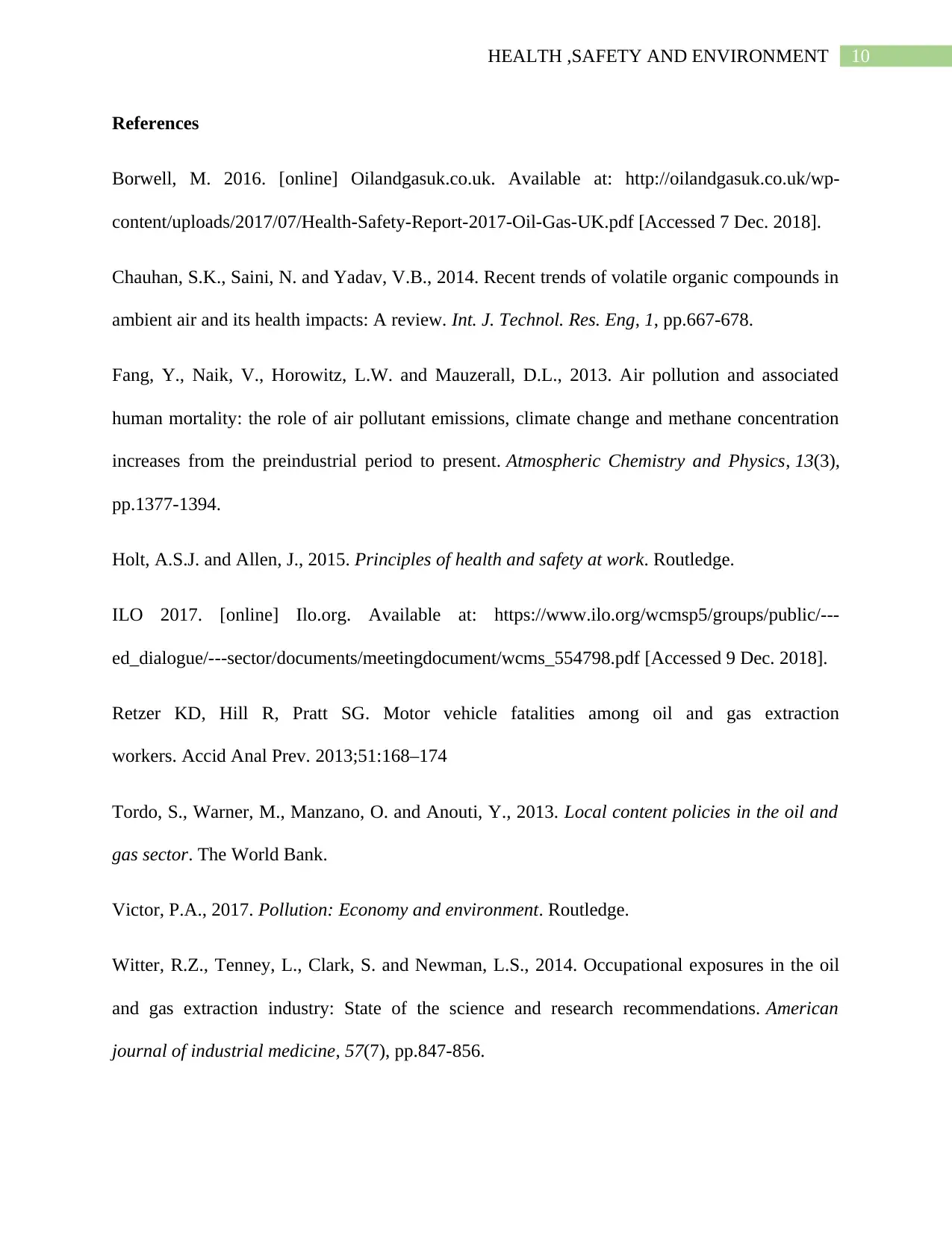
10HEALTH ,SAFETY AND ENVIRONMENT
References
Borwell, M. 2016. [online] Oilandgasuk.co.uk. Available at: http://oilandgasuk.co.uk/wp-
content/uploads/2017/07/Health-Safety-Report-2017-Oil-Gas-UK.pdf [Accessed 7 Dec. 2018].
Chauhan, S.K., Saini, N. and Yadav, V.B., 2014. Recent trends of volatile organic compounds in
ambient air and its health impacts: A review. Int. J. Technol. Res. Eng, 1, pp.667-678.
Fang, Y., Naik, V., Horowitz, L.W. and Mauzerall, D.L., 2013. Air pollution and associated
human mortality: the role of air pollutant emissions, climate change and methane concentration
increases from the preindustrial period to present. Atmospheric Chemistry and Physics, 13(3),
pp.1377-1394.
Holt, A.S.J. and Allen, J., 2015. Principles of health and safety at work. Routledge.
ILO 2017. [online] Ilo.org. Available at: https://www.ilo.org/wcmsp5/groups/public/---
ed_dialogue/---sector/documents/meetingdocument/wcms_554798.pdf [Accessed 9 Dec. 2018].
Retzer KD, Hill R, Pratt SG. Motor vehicle fatalities among oil and gas extraction
workers. Accid Anal Prev. 2013;51:168–174
Tordo, S., Warner, M., Manzano, O. and Anouti, Y., 2013. Local content policies in the oil and
gas sector. The World Bank.
Victor, P.A., 2017. Pollution: Economy and environment. Routledge.
Witter, R.Z., Tenney, L., Clark, S. and Newman, L.S., 2014. Occupational exposures in the oil
and gas extraction industry: State of the science and research recommendations. American
journal of industrial medicine, 57(7), pp.847-856.
References
Borwell, M. 2016. [online] Oilandgasuk.co.uk. Available at: http://oilandgasuk.co.uk/wp-
content/uploads/2017/07/Health-Safety-Report-2017-Oil-Gas-UK.pdf [Accessed 7 Dec. 2018].
Chauhan, S.K., Saini, N. and Yadav, V.B., 2014. Recent trends of volatile organic compounds in
ambient air and its health impacts: A review. Int. J. Technol. Res. Eng, 1, pp.667-678.
Fang, Y., Naik, V., Horowitz, L.W. and Mauzerall, D.L., 2013. Air pollution and associated
human mortality: the role of air pollutant emissions, climate change and methane concentration
increases from the preindustrial period to present. Atmospheric Chemistry and Physics, 13(3),
pp.1377-1394.
Holt, A.S.J. and Allen, J., 2015. Principles of health and safety at work. Routledge.
ILO 2017. [online] Ilo.org. Available at: https://www.ilo.org/wcmsp5/groups/public/---
ed_dialogue/---sector/documents/meetingdocument/wcms_554798.pdf [Accessed 9 Dec. 2018].
Retzer KD, Hill R, Pratt SG. Motor vehicle fatalities among oil and gas extraction
workers. Accid Anal Prev. 2013;51:168–174
Tordo, S., Warner, M., Manzano, O. and Anouti, Y., 2013. Local content policies in the oil and
gas sector. The World Bank.
Victor, P.A., 2017. Pollution: Economy and environment. Routledge.
Witter, R.Z., Tenney, L., Clark, S. and Newman, L.S., 2014. Occupational exposures in the oil
and gas extraction industry: State of the science and research recommendations. American
journal of industrial medicine, 57(7), pp.847-856.
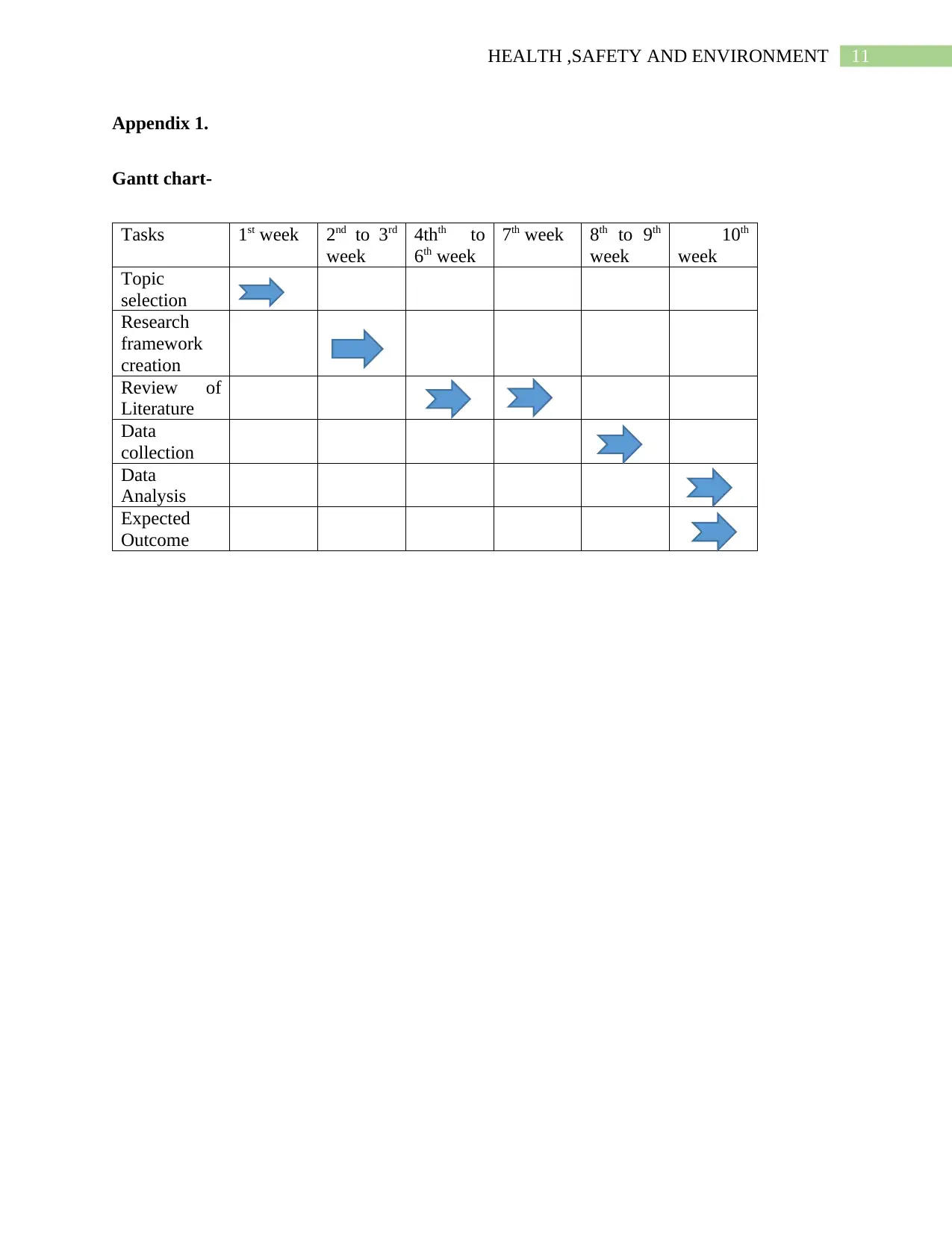
11HEALTH ,SAFETY AND ENVIRONMENT
Appendix 1.
Gantt chart-
Tasks 1st week 2nd to 3rd
week
4thth to
6th week
7th week 8th to 9th
week
10th
week
Topic
selection
Research
framework
creation
Review of
Literature
Data
collection
Data
Analysis
Expected
Outcome
Appendix 1.
Gantt chart-
Tasks 1st week 2nd to 3rd
week
4thth to
6th week
7th week 8th to 9th
week
10th
week
Topic
selection
Research
framework
creation
Review of
Literature
Data
collection
Data
Analysis
Expected
Outcome
⊘ This is a preview!⊘
Do you want full access?
Subscribe today to unlock all pages.

Trusted by 1+ million students worldwide
1 out of 12
Related Documents
Your All-in-One AI-Powered Toolkit for Academic Success.
+13062052269
info@desklib.com
Available 24*7 on WhatsApp / Email
![[object Object]](/_next/static/media/star-bottom.7253800d.svg)
Unlock your academic potential
Copyright © 2020–2025 A2Z Services. All Rights Reserved. Developed and managed by ZUCOL.




